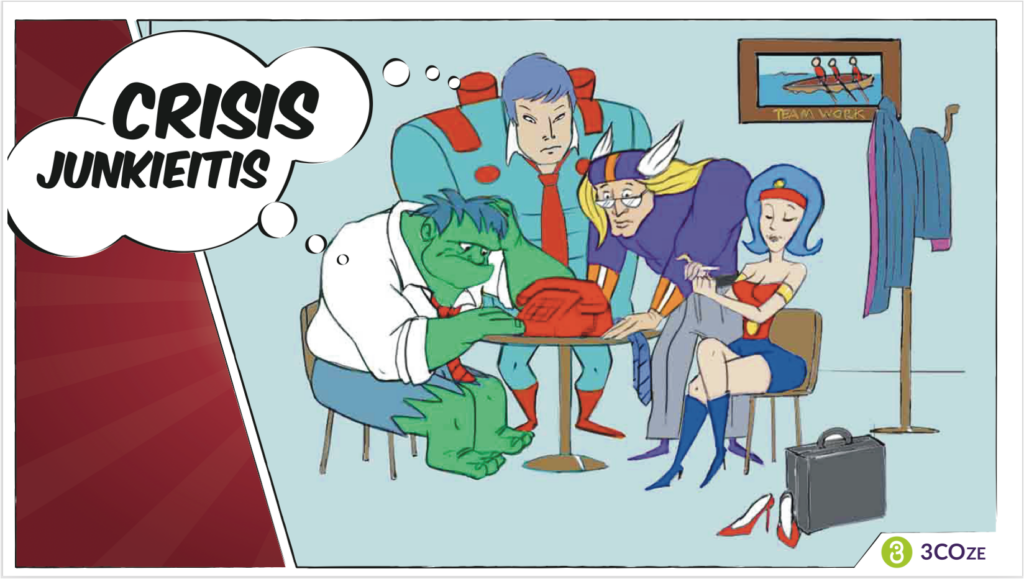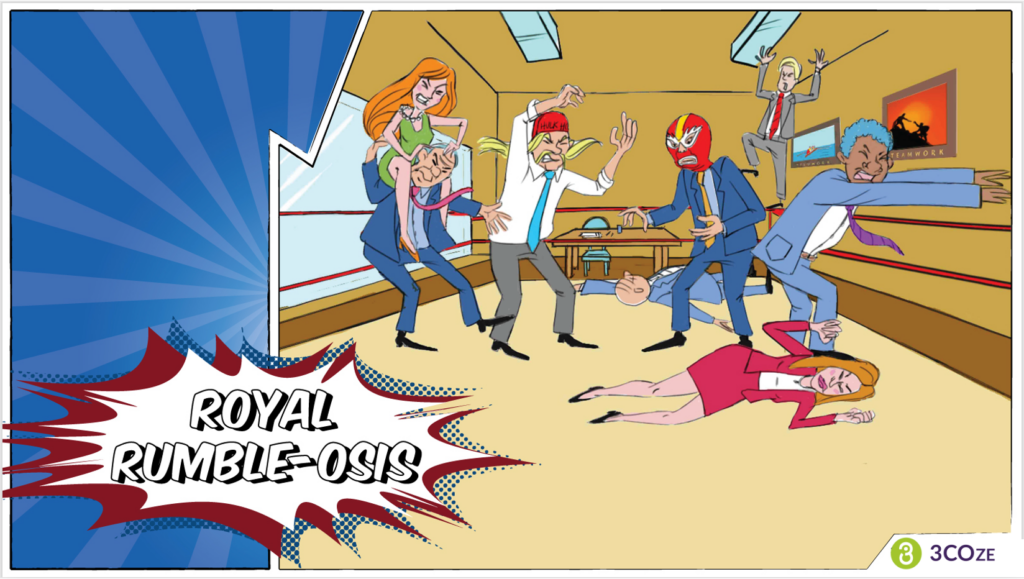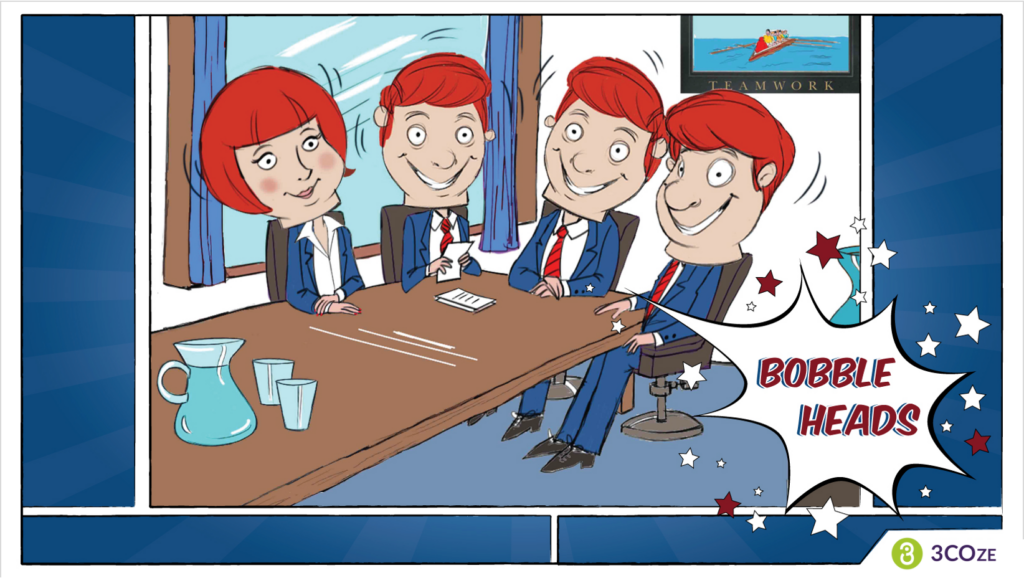Is your team dynamic toxic? Does it detract from your ability to get the job done? Is it ripping you and your colleagues apart? Or just ripping you apart?
Maybe it’s not that extreme. Maybe it’s not insufferable, but it sure is unpleasant.
Or maybe you think everything’s fine, but the poison in your team dynamic is like lead in the pipes. You don’t know it’s there but it’s slowly making you ill.
Want to identify what might be going on? Dig in.
What are Some Common Toxic Teams?
There are many ways your team dynamic can become toxic. I wrote about each of them in detail in my book You First: Inspire Your Team to Grow Up, Get Along, and Get Stuff Done. Let me give you the summary. Here’s the list of the toxic teams. Read them all or click on the name to jump right to the one that sounds familiar.
Crisis Junkie teams: lurch from one emergency to the next
Royal Rumble teams: yell-y, blustery, blowhard-y people
Bleeding Back teams: passive-aggressive, stab you in the back vibe
Spectator teams: not really teams at all. Collections of direct reports to the same person
Bobble Head teams: people going along to get along…uh-huh…yeah!
Crisis Junkie Teams
Definition: A team that needs an urgent and immediate threat to come together.

Original illustration by Peggy McEwan.
What does a Crisis Junkie Team look like?
Crisis Junkie Teams struggle to get anything done. At least when things are calm. Only when it turns into a four-alarm fire does a Crisis Junkie team kick into gear.
What Causes a Crisis Junkie Team?
Crisis Junkie teams are usually failings of the leader. Without the courage or the wherewithal to prioritize, make hard trade-offs, or ever ruffle any feathers, the leader leaves the team rudderless. Crisis Junkie Teams have:
- Poor Role Clarity: no sense of what each person is responsible for leads either to friction as you step on one another’s toes or inaction when no one is sure who’s responsible for moving a task forward.
- No Team Priorities: without the necessary priorities, alignment, or role clarity, everyone works on what matters most to them.
- Insufficient Resources: too many priorities and too few resources to accomplish them all. You’re trying to boil the ocean and you never have enough gas.
- Politics and Infighting: sandbox issues lead to petty squabbles that the feckless leader doesn’t have the courage to address
What is the Impact of Being a Crisis Junkie Team?
Crisis Junkie teams are costly to members and to the business. Common consequences include:
- Knee-jerk reactions that are from old-playbooks and don’t fit the current climate
- Risky decisions and shoddy solutions based on an oversimplification of the situation
- Deteriorating relationships with other teams who feel they can’t depend on you
- Failure to execute strategy
Royal Rumble Teams
Definition: A team where passion and enthusiasm are misdirected into personal and unproductive conflict among members.

Original illustration by Peggy McEwan.
What does a Royal Rumble Team look like?
With Royal Rumble Teams, it’s less about what they look like and more about what they sound like. The volume is usually set to 11. There’s lots of yelling, frequent ping-ponging back-and-forth, and very little listening.
What Causes a Royal Rumble Team?
Royal Rumble teams are often a result of people with high IQ and low EQ (emotional intelligence). On the plus side, members of Royal Rumble teams are highly engaged, but often they’re passionate about their project, their ideas, and their vision of the future, but not a shared version of any of those. Royal Rumble Teams have:
- Low Emotional Intelligence: smart, powerful people who throw their intellectual weight around trying to coerce people into seeing things their way. (It is also possible that EQ is high but wielded in a shrewd, manipulative way.)
- Bad Meeting Management: a weak or conflict-loving chairperson allows a discussion to devolve into a cage match.
- Individual Rewards and Recognition: high stakes rewards tied to individual performance that creates heroes and zeros.
What is the Impact of Being a Royal Rumble Team?
Royal Rumble teams are particularly noxious, particularly for anyone around the table who doesn’t like conflict. Common consequences include:
- Slow decision making as no one considers alternatives or cedes territory
- False choices between black and white options
- Turnover of people who seek a more civilized environment
- Embarrassing behavior and the accompanying damage to people’s reputations
Bleeding Back Teams
Definition: A team where conflict and differences of opinions are expressed through passive-aggressive means such as humor, gossip, and back-channel decision-making.

Original illustration by Peggy McEwan.
What does a Bleeding Back Team look like?
Bleeding Back teams look amicable on the surface but if you listen in to the talk at the water cooler, things aren’t so rosy. There is little progress on a Bleeding Back team because decisions are either reopened or simply ignored by mutinous members.
What Causes a Bleeding Back Team?
Bleeding Back teams are common in places where no one wants to appear oppositional or where they lack the skills to dissent productively. They’re full of people who think they’re being nice by stabbing you in the back but never in the front. Bleeding Back Teams have:
- Lack of Feedback: people who are unable or unwilling to give feedback that nips passive-aggressive behavior in the bud.
- Low Trust and Safety: evidence or legitimate suspicion that surfacing issues is a bad idea.
- Backchannels: opportunities to get your way by going around the official decision-making protocol to leverage relationships with the boss or others with power
What is the Impact of Being a Bleeding Back Team?
Bleeding Back teams slowly erode your faith in your team and make you question who you can trust. Common consequences include:
- Poor decision-making because options and risks aren’t surfaced.
- Slow implementation as team members continue to challenge or refuse outright to enact team decisions.
- Inter-team confusion as colleagues in other departments get opposing messages from different members of the team.
- Mistrust and second-guessing of colleagues that tests trust and eats away at engagement
- Stress. And More Stress. As you feel more and more like relationships are built on quicksand
Spectator Teams
Definition: A team where the whole is equal to the sum of the parts because individual members contribute only in their own areas, with little discussion or debate.

Original illustration by Peggy McEwan.
What does a Spectator Team look like?
Spectator teams look like the people at a tennis match. Usually, there are only two people talking and everyone else is looking from one to the other. No one interjects. No one opens up the narrow thinking. No one spots risks or challenges assumptions. They just stare blankly.
What Causes a Spectator Team?
Spectator teams are a result of the profound overwhelm people are experiencing. There is too much information, too many priorities for anyone to feel fully confident in their own area, let alone being informed enough to weigh in on someone else’s. Spectator Teams have:
- No Team Mandate: clear priorities and tasks for each individual, but not overarching team purpose that requires everyone to co-create projects.
- Premium on Technical Expertise: the belief that only the deepest experts have anything worth contributing to a discussion.
- Different Capability: weaker team members who defer to those with better knowledge, greater experience, or just more ruthless debating skills.
What is the Impact of Being a Spectator Team?
Spectator teams are a giant waste of time. They create a false sense of security while churning out decisions that haven’t had the benefit of diverse thought. Common consequences include:
- Wasted time in meetings where few are contributing.
- Siloed thinking that underappreciates different perspectives.
- Implementation struggles as issues left unexposed in planning start to pop up.
- Disengagement among team members who don’t feel they’re part of a team at all.
Bobble Head Teams
Definition: A team that is too aligned and doesn’t have enough diversity or dissent to make good decisions.

Original illustration by Peggy McEwan.
What does a Bobble-Head Team look like?
Bobble Head teams look really, really happy. I think of them as the families on the game show Family Feud. Uncle Larry throws out a ridiculous answer and everyone hoots and hollers, “Good answer! Good answer!” There’s lots of nodding and agreeing on a Bobble-Head team. Because of this, they are often not recognized as toxic because toxic positivity is welcomed and even encouraged in some organizations
What Causes a Bobble-Head Team?
Bobble Head teams are a result of placing greater emphasis on a harmonious team dynamic than on the quality of the team’s output. Bobble Head Teams have:
- Too Much Familiarity: humans don’t know what we like, we like what we know.
- Homogeneity: groupthink caused by team members being too much alike
- Overbearing Team Leader: some alignment is forced alignment where dissent isn’t tolerated.
What is the Impact of Being a Bobble-Head Team?
Bobble Head teams are dangerous because their risks are so insidious. Common consequences include:
- Poor decisions because risks aren’t appreciated and therefore not mitigated.
- False confidence in the decision born of so many endorsements and so few challenges of ideas.
- Inter-group tensions that build as the team becomes an “us” and others become “them.”
- Loss of self for team members as they are constantly matching their pitch to the choir.
- Risk of blame when the poor decisions cause calamity and the finger pointers want someone to hold accountable.
The Cost of Being on a Toxic Team
Did you recognize your team in one of these descriptions? People often tell me that their team is a melange, a potpourri, of several of these dysfunctions, or that the particular dysfunction depends on the day.
If your team is developing a toxic dynamic, it’s important to recognize it before it starts to impact your customers, your relationships, or your stress levels.
Still worried about your toxic team?
It’s not only poor team dynamics that can make you feel like you’re in a toxic work environment. Check out the four other definitions of a toxic work environment here, along with a bunch of other ideas to help you navigate the kinds of work environments that are harmful to your wellbeing. Topics covered include:
- What Makes a Workplace Toxic?
- The Relationship Between Psychological Safety and Toxicity
- Should I Quit my Toxic Workplace?
- How to Survive a Toxic Work Environment
- Catalog of Toxic Bosses
- How to Avoid Joining Another Toxic Company
I’ve also got this quick video on the different flavors of toxic team, if that’s more your thing:
Further Reading
An Exercise to Expose Team Dysfunction in One Meeting
Why your volunteer team sucks and how to make it better
Top 10 Signs that Your Dysfunctional Team is Getting Better
